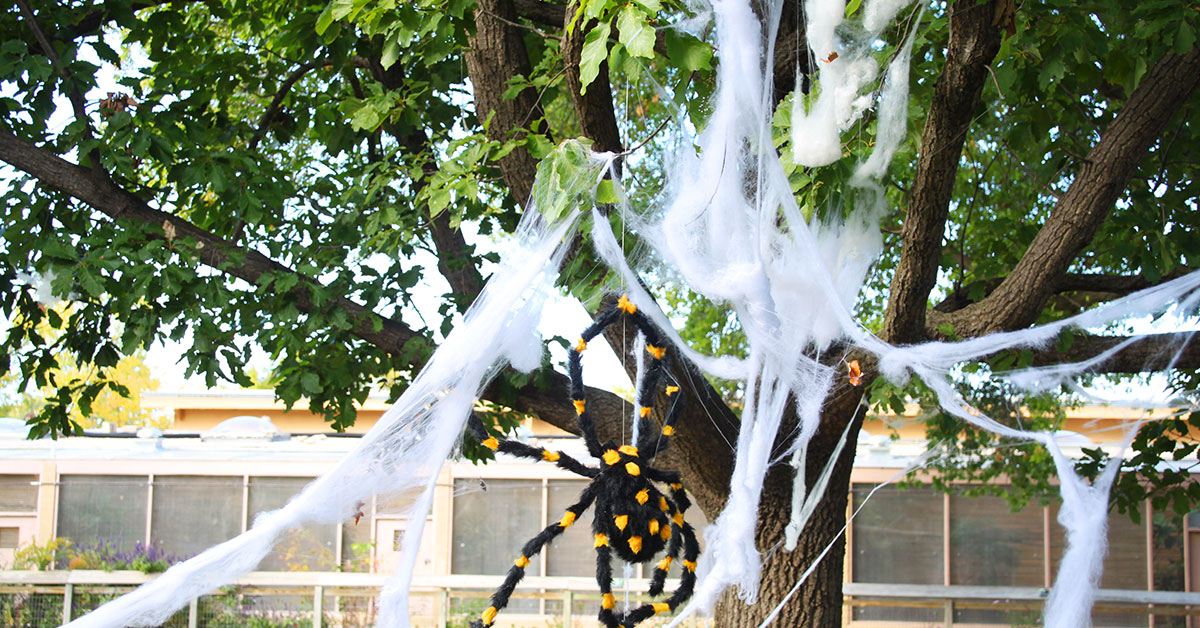
Fake Spider Webs Are Deadly To Wildlife (Don’t Buy Them!)
- Thomas Nelson
- October 17, 2023
- Animals, Sustainable Living
- 0 Comments
As the seasons shift and the winds turn cooler, many homes and neighborhoods across the world start to adorn themselves in eerie decor, preparing for the annual celebration of Halloween. Among the traditional symbols of this spooky holiday, one decorative item stands out – fake spider webs.
Stretching across porches, windows, and fences, these synthetic cobwebs have become an iconic part of Halloween decor. Yet, hidden beneath their gossamer threads lies a darker truth: the environmental cost of fake spider web decorations.
While they may add a touch of frightful fun to our festivities, their impact on the environment is far from harmless. In this article, we will unravel the web of consequences that these decorations weave, shedding light on why fake spider web decorations are bad for the environment and urging a reevaluation of our decorating choices in the spirit of a more sustainable future.
Why fake spider webs are awful for wildlife and the environment
Fake spider web decorations, often used as Halloween decorations or for other festive purposes, can have negative impacts on the environment and wildlife in various ways:
- Wildlife entanglement: The artificial spider webs can trap insects and other small wildlife, such as birds, bats, and beneficial insects like bees and butterflies. These creatures may become entangled in the decorations and suffer injury or even death.
- Non-biodegradable materials: Many fake spider web decorations are made from non-biodegradable materials like plastic or synthetic fibers. When these decorations are discarded improperly, they can contribute to plastic pollution in the environment, which poses a significant threat to wildlife and ecosystems.
- Litter and pollution: Fake spider web decorations may end up as litter in outdoor environments, especially if not properly disposed of. This litter can harm wildlife that ingest or become entangled in the decorations or the associated trash.
- Aesthetic pollution: When fake spider webs are left outdoors for extended periods, they can become unsightly and negatively impact the aesthetic appeal of natural landscapes and outdoor spaces. They can be difficult to fully remove from branches, trees, and shrubs and can become stuck for extended periods of tiem.
- Environmental degradation: The manufacturing and disposal of fake spider web decorations can contribute to air and water pollution, as well as greenhouse gas emissions, depending on the production methods and materials used.
- Resource consumption: The production of fake spider web decorations requires the use of resources such as energy, water, and raw materials. This consumption of resources contributes to the overall environmental footprint associated with these decorations.
To minimize the negative impacts of fake spider web decorations on the environment and wildlife, it’s important to:
- Use decorations made from biodegradable or eco-friendly materials whenever possible.
- Properly dispose of decorations by recycling or disposing of them in a responsible manner.
- Avoid leaving decorations outdoors for extended periods, especially in natural environments.
- Consider the potential wildlife hazards when choosing and placing decorations.
- Educate others about the environmental impacts of decorative items and encourage responsible decoration practices.
Eco-friendly Halloween decorations
When it comes to Halloween decorations, there are plenty of eco-friendly alternatives to fake spider webs and other decorations that can help you celebrate the spooky season without harming the environment. Here are some ideas for eco-friendly Halloween decorations to consider:
- Natural Pumpkins: Instead of plastic or foam pumpkins, opt for real, locally grown pumpkins. After Halloween, you can compost them or use them for cooking.
- Biomass Banners: Use banners and decorations made from biodegradable materials like paper, hemp, or jute. These materials decompose quickly and don’t contribute to long-lasting waste.
- Recycled or Secondhand Decor: Look for Halloween decorations at thrift stores or online marketplaces. You can find gently used items and give them a new life instead of buying new ones.
- DIY Creations: Get creative and make your own Halloween decorations from recycled materials. Old sheets can be turned into ghosts, and cardboard boxes can become tombstones or spooky silhouettes.
- Edible Decorations: Consider using edible decorations like apples, gourds, or other seasonal fruits and vegetables. These can be part of your Halloween decor and later serve as a delicious snack or addition to your meals.
- Candlelight: Instead of plastic or battery-operated candles, use real candles in reusable containers or lanterns. Be sure to follow safety precautions when using open flames.
- Natural Garlands: Create garlands and wreaths from natural materials like leaves, pinecones, and branches. These decorations can be composted after use.
- Reusable Decor: Invest in quality decorations that you can reuse year after year. Look for items made from durable materials like wood or metal.
- Solar-Powered Lights: If you want to add some illumination to your decor, choose solar-powered LED lights. They charge during the day and provide a spooky glow at night without consuming electricity.
- Zero-Waste Parties: If you’re hosting a Halloween party, consider using reusable tableware, cloth napkins, and avoid single-use plastic items like straws and disposable plates.
- Eco-Friendly Paints: If you’re crafting or painting decorations, use non-toxic, water-based paints that are safer for both your health and the environment.
- Natural Fabrics: When creating or choosing costumes, opt for natural fabrics like cotton, wool, or hemp instead of synthetic materials. These materials are biodegradable and have a smaller environmental footprint.
By choosing eco-friendly Halloween decorations and adopting sustainable practices during the holiday season, you can enjoy the festivities while minimizing your impact on the environment. It’s a ghoulishly good way to celebrate with a conscience.

